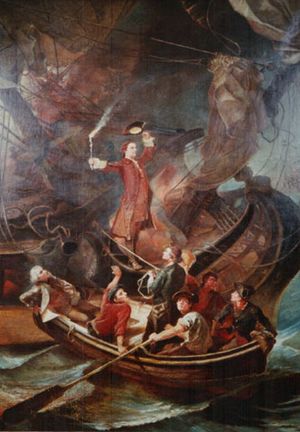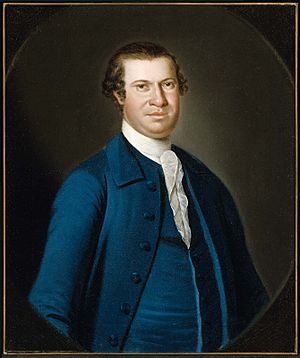Peggy Stewart (ship) facts for kids
The Peggy Stewart was a ship from Maryland. It was burned on October 19, 1774, in Annapolis. This happened because the ship broke a rule about not importing tea. This rule was part of a boycott against Britain. The boycott started after the British took over Boston following the Boston Tea Party. This event is now known as the "Annapolis Tea Party".
Contents
Why the Peggy Stewart Was Burned
In 1770, a ship called the Good Intent arrived in Annapolis. It carried goods from London. Some of these goods were subject to British taxes. Local merchants had agreed to boycott goods with these taxes. The tax was part of the "Townshend Acts" from 1767.
Customs officials would not let any goods off the ship. They said taxes had to be paid first. But the local committee supervising the boycott refused to pay any taxes. So, the Good Intent had to sail back to London. It still had all its goods on board.
Later, Britain removed most taxes, but not on tea. Then, the Tea Act of 1773 allowed only one company, the British East India Company, to sell tea in America without paying tax. Americans thought this was unfair. This led to the famous Boston Tea Party. After that, many Americans started boycotting tea again.
The Ship's Secret Cargo
Most ship captains refused to carry tea. But in 1774, a merchant named Thomas Charles Williams found a way around this. He loaded 2,320 pounds (about one ton) of tea onto the Peggy Stewart. This ship was owned by James Dick and Anthony Stewart.
The worried captain, Richard Jackson, was told the packages held linen. But to avoid trouble, Williams correctly listed the tea on his Customs papers. So, the captain learned his cargo included tea. He knew this would cause big problems in America. The ship also carried 53 indentured servants. They had a very unpleasant trip because the ship leaked.
Arrival in Annapolis and Trouble Begins
The Peggy Stewart arrived in Annapolis on October 14, 1774. Anthony Stewart learned about the tax on the tea. He told Thomas Williams's brothers, Joseph and James. They refused to pay the tax. They set up a meeting with the committee that oversaw the tea boycott.
Stewart was worried. He knew the ship couldn't unload any cargo until the tea tax was paid. This included the 53 indentured servants. He feared they might die if they stayed on the leaky ship. So, Stewart promised to pay the tea tax himself. He got the servants off the ship quickly. The rest of the cargo stayed on board, waiting for the committee's decision.
Discussions and Public Anger
Only four committee members were available for a meeting that day. They invited the public to join the discussion. They decided that all cargo except the tea could be unloaded. Twelve people were chosen to make sure this happened.
A full committee meeting was set for October 19. During the next five days, many things happened. Stewart and the Williams brothers met with committee chairman Charles Carroll. They agreed to burn the tea and apologize in the Maryland Gazette newspaper.
However, a committee member named Mathias Hammond published a flyer. It criticized Stewart. It didn't mention that the Williams brothers had told him about the tea. This made many people very angry.
The Final Committee Meeting: October 19
The second committee meeting was crowded. Many people came to make an example of Mr. Stewart. The Maryland Gazette reported on the meeting. It said the committee thought if the owners destroyed the tea and apologized, nothing else should happen. But the crowd was not happy with this.
Then, Mr. Stewart offered to burn the ship along with the tea. This offer satisfied the angry crowd.
The Ship is Burned
The Peggy Stewart was moved to a good spot. It had its sails up and flags flying. Anthony Stewart, Nehemiah Moxley, Joseph Williams, and James Williams read a statement. They apologized for their actions. This apology was later printed in the newspaper. Then, they set the ship and the tea on fire.
Within a few hours, the Peggy Stewart burned down to the waterline. Many people watched this happen. This event is now known as the "Annapolis Tea Party."
Anthony Stewart's Life After the Burning
Anthony Stewart and his family moved to New York during the American Revolutionary War. He was part of a group called the Associated Loyalists. After the war, in 1783, he tried to start a new community in Nova Scotia called New Edinburgh. The plan didn't fully work out, but the community still exists.
Even though he lost money from the "Tea Party," Stewart remained wealthy. However, the 1,200 acres (4.9 km2) of land he owned in Maryland were taken by the government after the war. Sadly, he died in 1791 while on a business trip to Annapolis.
Remembering the Peggy Stewart
After the American Revolutionary War, people in Maryland saw the burning of the Peggy Stewart as a brave act. They thought the angry crowd were true patriots for standing up against the British Tea Act.
On October 19, 1904, the city of Baltimore honored the event. A mural called The Burning of the Peggy Stewart was painted. It is in the Clarence M. Mitchell, Jr. Courthouse.
In 1974, a silver ingot was made to mark the 200th anniversary of the burning. There is also a tea blend called "Peggy Stewart Tea." Every year, a ceremony is held in Annapolis to remember the event. The story was also told in a children's book called Ahoy, Peggy Stewart in 1956.
Images for kids





